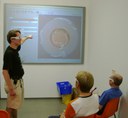Rechensysteme und Infrastruktur
BITFLIP - DATA ASSIMILATION
To support the research in data assimilation of the Geodynamics working group the GeoComputing group operates the machine bitflip. [more]
CACHEMISS - COMPUTATIONAL GEOPHYSICS
To support the research in the context of computational geophysics the GeoComputing group operates the machine cachemiss. [more]
DATARACE - COMPUTATIONAL GEOPHYSICS
To support the research in the context of computational geophysics the GeoComputing group operates the machine datarace. [more]
EXCEPTION - COMPUTATIONAL SEISMOLOGY
To support the research in the context of computational seismology the GeoComputing group operates the machine exception. [more]
GEOWALL - INTERACTIVE 3D VISUALISATION
Numerical simulations models are of constantly growing importance in the Geosciences. Due to increased computing power and improved algorithmics such models tend to deliver an ever increasing amount of data. However, as Richard Hamming put it "the purpose of computing is insight, not numbers!". Thus, the visualisation of simulation results plays a crucial role. [more]
HEISENBUG - COMPUTATIONAL SEISMOLOGY
To support the research in the context of computational seismology the GeoComputing group operates the machine heisenbug. [more]
KERNELPANIC - EARTHQUAKE PHYSICS
To support the research of the earthquake physics working group the GeoComputing group operates the machine kernelpanic. [more]
KRAKATAU - RESERVOIR MODELLING
To support the research in the context of reservoir modelling the GeoComputing group operates the machine krakatau. [more]
MEMORYLEAK - EARTHQUAKE PHYSICS
To support the research in the context of earthquake physics the GeoComputing group operates the machine heisenbug. [more]
OVERFLOW - COMPUTATIONAL GEOPHYSICS
To support the research in the context of computational geophysics the GeoComputing group operates the machine overflow. [more]
Retired Systems
BORGCUBE - DATA ASSIMILATION
To support our research in data assimilation the GeoComputing group operates a small cluster of four HP Proliant DL785 G5 machines. The cluster consists of 32 AMD QuadCore Opteron 8384 (Shanghai) CPUs with a total of 128 cores and 1 TByte of main memory. [more]
BUSERROR - DEVELOPMENT SYSTEM
Buserror is an HP Proliant DL835 G7 machine intended mainly for code development and test-bed for tuning our applications for multi-core systems. In this respect it acts as a mid-term replacement for our aging Coredump system. [more]
COREDUMP - 128 GB MULTI-CORE SMP SERVER
The GeoComputing group operates a symmetric multi-processing (SMP) system with 16 cores and 128 GB of main memory. It acts as compute server for applications requiring a huge amount of directly addressable memory and as a test-bed for porting our applications to multi-core systems. [more]
DEADLOCK - COMPUTATIONAL GEOPHYSICS
The GeoComputing group operates an ASUSTeK COMPUTER INC. ESC4000 G3 Series server with 256 GB of main memory. It acts as compute server for applications requiring a huge amount of directly addressable memory and as a test-bed for porting our applications to multi-core systems. [more]
SEGFAULT - COMPUTATIONAL SEISMOLOGY
Our segfault system is a Fujitsu-Technology PRIMERGY RX600 S6 machine mainly intended for simulations in the context of computational seismology. It is an Intel Westmere-EX based machine with 40 cores that can run 80 threads (near) simultaneously making use of Intel's hyper-threading technology. [more]
TETHYS - TECTONIC HIGH-PERFORMANCE SIMULATOR
Between 2006 and 2012 Munich Geophysics operated a 160 core AMD Operaton cluster with a theoretical peak performance of 0.8 TFLOP. The main objective of the cluster was to serve as a tool to perform capacity simulation with numerical models form Geophysics. The cluster was designed for topical computing, i.e. its intended use was limited to a set of certain key applications. [more]
TETHYS-2G
From 2006 to 2012 Munich Geophysics operated the first generation of the Tectonic High-Performance Simulator. TETHYS was a 160 core AMD Operaton cluster with a theoretical peak performance of 0.8 TFLOP. In May 2012 this system was replaced by a new generation blade based cluster with 864 Intel Xeon cores. [more]


















